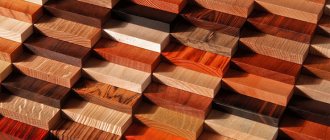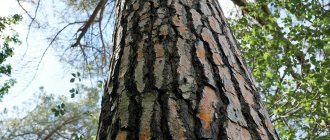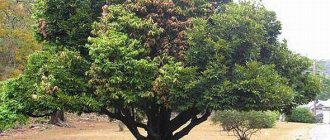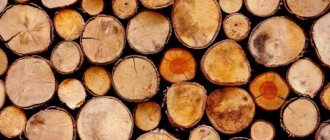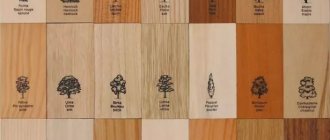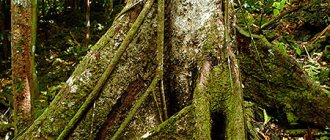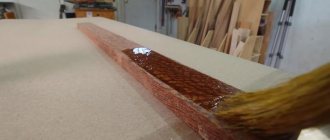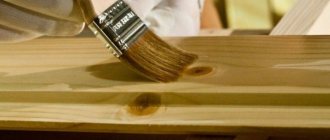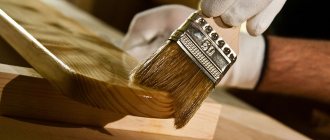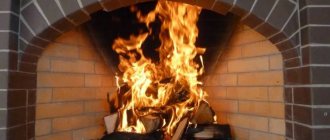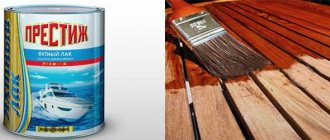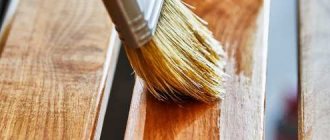For carpentry work, dry wooden blanks are used, which go a long way from their original state. Let's talk a little about this process and some of its features that affect the final result of woodworking.
The tree trunk, from which bars and boards are then cut, has a characteristic shape, close to cylindrical, while having some slope - a gradual decrease in diameter from the base to the top. The lower, basal, thicker part of the trunk is called the butt, then comes the trunk itself and the thinner top.
Tree species - pine
Among Russian tree species it has found very wide application. Pine wood is pale yellow or yellow-red. It is of medium hardness and quite easy to process. The straightness of the trunks makes this type of wood popular in the construction of houses. It planes well along, but poorly across. The glue sticks the pine together well and firmly.
It can be used for many crafts and is used in inexpensive doors, furniture, and window frames. At high humidity, pine may turn blue. On hot sunny days, resinous pine trees can release resin.
Heartwood and sapwood.
As already mentioned, the growth of a tree and the development of its trunk occurs due to the growth of the outer layers adjacent to the bark. If you look closely at a cut of a tree, then in addition to the annual rings, you will find that in some species the wood is evenly colored, while in others the central part is darker than the outer part.
The dark-colored part of the wood is called the core, and species with a pronounced core are called heartwood. The lighter outer part of the heartwood is called sapwood.
Some species have a central part that does not differ in color from the outer part and they are called mature wood. Heartwood is formed in all types of wood, but its darkening occurs under certain conditions and, therefore, mature wood is wood with an uncolored heartwood.
Among the conifers, larch, pine, cedar, yew, and juniper have a colored core; among deciduous trees - oak, ash, elm, elm, elm, walnut, poplar, willow, rowan. Sapwood species include many deciduous trees - birch, alder, linden, hornbeam, maple, boxwood, pear, and hazel. Mature wood among coniferous species is spruce and fir, and among deciduous species - beech, aspen and some others.
In a growing tree, sapwood serves to conduct water up the trunk (from the roots to the crown) and to deposit reserve nutrients. The formation of the kernel depends on the breed, age, growing conditions and other factors. The process of kernel formation involves the death of living wood elements, blockage of water supply pathways, and the deposition of resin and calcium carbonate. Wood in this zone is impregnated with tannins and dyes, as a result it darkens, its density increases slightly, and its resistance to rotting increases.
Saturated with juices in different ways, these parts of the trunk also dry out differently. The boards in which the core meets the sapwood are located, when drying, they bend towards the sapwood, since the core has less shrinkage.
Larch
A very hard tree species. It is considered one of the best for construction and carpentry work. Its wood is red. It is significantly more resistant compared to oak. In water, it can increase its strength to such an extent that it is problematic to drive a nail into a page. An example of strength is Venice, which stands on larch.
Larch is very difficult to process (it is recommended to process only freshly cut trees), but the surface after processing is smooth. It hardly warps. The disadvantages of larch include its tartness, as well as its high specific gravity.
Features of choice.
When choosing carpentry material, you must follow certain rules. The best choice is boards cut as close to the middle as possible, the so-called “medium” and central ones. They warp less from shrinkage when drying.
The more perpendicular the annual layers are to the side face of the board, the less it warps. The maximum yield of such boards is obtained with the so-called “radial” cut. Radial cutting and sawmill equipment designed for this is the topic of a separate article. In short, with radial cutting, sawing occurs from the center of the log to its edges and an individual cutting map is used. This is the main difference from the classic “tangential” cutting scheme, when sawing the log and carriage is carried out sequentially in the horizontal (manual band sawmills) or vertical (frame and disk sawmills) direction.
When cutting softwood into boards, you need to discard the soft core. This, of course, increases the amount of waste during preparation, but there will be less of it during operation, and the final products are more reliable, stronger and more beautiful.
Wood with wide annual rings is easier to process, but is subject to significant shrinkage; wood with small annual rings is more beautiful, but at the same time heavier. Heartwood is denser and heavier than sapwood and is preferable for facing work. In general, the greater the difference in color between the annual rings, the more interesting the wood is.
Wood defects are revealed by external inspection and by a fresh cross-section. Boards with a spiral direction of longitudinal fibers (slant), with internal cracks, both radial (metic) and annular (otlup), the wood of which is colored by putrefactive fungi (blue), with a large number of knots, resin pockets, tobacco and falling knots, are subject to rejection. .
Cedar
It is considered a variety of pine, but with different properties. Its wood is pinkish in color, which tends to darken quickly and significantly in the sun. Cedar is a soft tree and is well processed; it has a pleasant smell and antibacterial properties. Moths do not tolerate this material. Cedar is used in construction, for making furniture and various crafts. Carvers enjoy working with this material.
Cedar is a healing tree and is used in folk medicine. Its wood is resistant to rot and is not susceptible to wormholes.
Tree rings.
The first thing that catches your eye on a cut of freshly cut wood is a clearly defined pattern in the form of concentric circular stripes surrounding the core. These are the so-called “annual layers”, which are most evident in trees grown in places characterized by sharp temperature changes between seasons. The wood of southern tropical species is distinguished by layers with a blurred boundary of rings and less variation in color and width.
Darker and denser layers of wood are autumn, wider and lighter layers belong to spring and summer. Understanding the structure of the annual layers of wood is of significant practical importance, since the properties of wood depend on their size and structure. The worse the conditions in which the tree grew, the smaller the rings and the denser and stronger the wood, and by the number of annual layers it is possible to determine the age of the part of the trunk where the cut was made.
Tree species - linden
It has light white wood. Easy processing makes it popular among carvers. Linden is not afraid of dampness and warps a little, however, it is affected by fungi. After drying, its strength improves. Sometimes floors are made from it (they are warmer than pine), furniture and baths are made. Linden is used in baths because of its unique smell, which lasts for several years.
It is used in many items where wood needs to be processed without much difficulty. For example, in shoe lasts, parts of wooden tools.
Areas of use of the material
By and large, all lumber can be divided into two large directions, approximately equal in production volumes. This is wood that is used for construction needs and furniture wood.
What can be made from a log.
Scaffolding
Since we are already talking about joinery wood, two types of it are used in construction - sawn and planed boards. The price of sawn material is lower and more affordable. Sawn wood is called sawn wood because after cutting it is not subject to further processing. Such wood, as a rule, comes with natural moisture or dried under natural conditions.
Now let's look at the moisture content of the construction timber. Wood with a natural moisture level is called wood that has been freshly sawn and cut on machines.
It is from this material that various types of rough coverings are constructed. This could be sheathing the roof truss system, laying the subfloor, or constructing formwork for the foundation.
Scaffolding parameters.
But using freshly cut timber is almost always a risk; such material is susceptible to external influences and can change its shape at any time.
In particular, the raw mass is subject to warping and winging:
- Warping is a change in the transverse shape of a product. This is when the board bends in a semicircle in any direction.
- The term winging refers to the twisting or bending of a plane with a screw.
Possible changes in the geometry of the material during the drying process.
Important: both of these defects occur if the instructions for storing wood are violated, as well as if the wood is unevenly dried.
Organizing proper drying of such products in artisanal conditions with your own hands is simply simple. In fact, all you need is a good shed and working hands. Edged or unedged boards are stacked under a canopy in such a way that the planks lie with a small gap both along the plane and between the rows.
To do this, transverse strips with a thickness of about 30 mm are laid between the rows at intervals of 1 - 1.5 m.
Drying in stacks.
But under natural conditions, only industrial wood can be dried. To produce, for example, lining, dry wood boards from pine or other construction wood are used.
Such material must undergo a chamber drying stage and at the exit must have a moisture content not exceeding 12–16%. Due to this, it is subject to minimal shrinkage, up to 3%, and also has stable dimensions and shape.
As for the type of wood, inexpensive coniferous solids are most often used for the manufacture of load-bearing structures and rough coverings. In addition to its low cost, such wood, due to its high resin content, has natural protection against biological pests. As a rule, hardwood is used to make boards intended for finishing coatings and finishing work.
Finishing joinery material.
Furniture forest
Furniture boards for carpentry work have disproportionately higher characteristics. The price of this timber is usually an order of magnitude higher than that of construction timber.
This difference is caused by the need for mandatory chamber drying. Only dry wood is used for furniture production.
According to the technology, in order to avoid defects caused by rapid chamber drying, the “wild” log passes through stripping machines, where the bark and top layer are removed, after which the material is immediately sent to the drying chambers. Only after the core moisture reaches 12% is the log sent for cutting.
This approach makes it possible to avoid cracking and deformation of finished products.
Furniture panel made from wood planks.
Another important point is to protect the array from mold, rot and biological pests. Depending on the purpose of the products and the required depth of impregnation, this can be done with your own hands or using industrial equipment.
Experts recommend performing any processing of this kind only after drying the array. Raw wood does not absorb foreign compounds well, plus during the drying process, these same compounds will evaporate intensely, which can be dangerous to human health.
Industrial drying of material.
The video in this article provides information on the topic of carpentry.
Beech
Mainly distributed in Europe. Its wood is considered hard and has a reddish-brown color. Beech wood of mountain origin has the highest quality. Its strength is slightly inferior to oak, but it is a champion among tree species that are used for ornamental work. It lends itself very well to planing and turning on a lathe.
Beech is resistant to splitting, but has poor resistance to cracking. It cuts well, but at the same time crumbles across the grain in fine carvings. It is used for interior decoration, making parquet, furniture, and musical instruments. When wet, beech warps.
Cross-layered.
A tree trunk does not always grow evenly throughout its life. For various reasons, the trunk can twist around an axis and at the same time, its constituent fibers form a spiral. In scientific terms, this phenomenon is called tangential (tangential) inclination of fibers or in everyday life - “oblique layering”.
Cross-layered wood is measured as a percentage; a deviation of the fibers of 1 cm per 1 m of length is 1% of the cross-layered wood. Cross-layering significantly reduces the tensile and bending strength of wood, especially if the cross-layering is more than 5%.
The boards obtained from such a trunk have an oblique direction of fibers, running steeply inward from one wide side of the board (face) to the other. The fibers are short, the board is fragile when bending and is unsuitable for cutting into bars.
